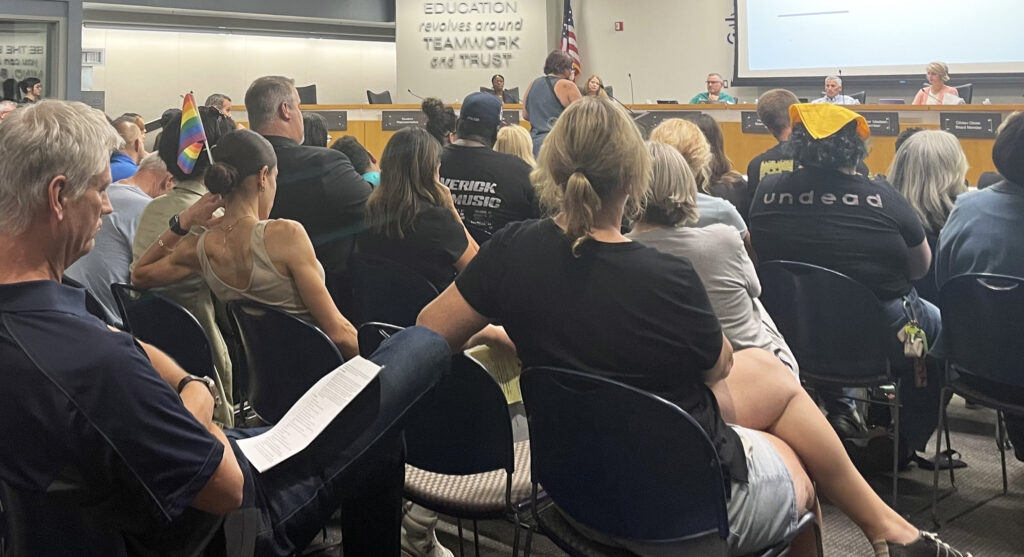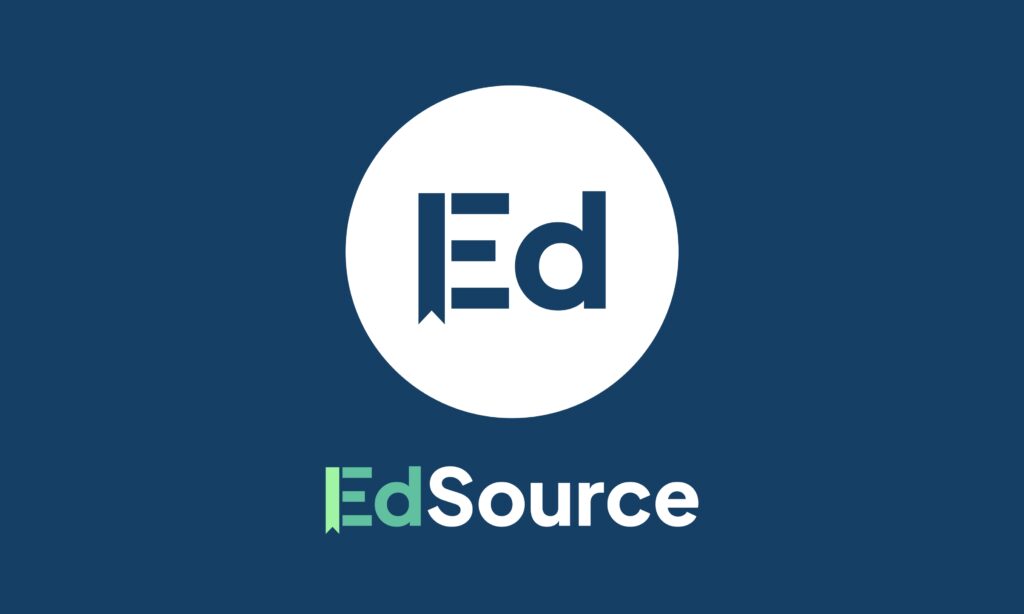
Nearly 100 parents, former students and educators filled the Sept. 20 Clovis Unified school board meeting to voice their opinions on the prospect of a parental notification policy.
Credit: Lasherica Thornton / EdSource
Recent Clovis Unified school board meetings have been filled with posters bearing contrasting messages. “Support parental notification in schools. Stop keeping secrets from parents” as well as “Stop forced outing.”
With those starkly different messages in the background, nearly 100 people spoke at the Sept. 20 board meeting, joining a debate that’s sweeping the state: parents’ right to know how their children identify at school versus students’ right to privacy about gender identity and expression.
The contentious discourse came to Clovis Unified not because of a proposed school board policy — as has been the case in other school districts, including Chino, Temecula, Anderson Union High, Murrieta Valley and Rocklin — but because of a Student Site Plan, an optional form that, some say, could undermine students’ right to privacy by outing them to their parents. The district says it uses the form to gauge students’ needs for access to facilities such as restrooms and locker rooms.
Under a 10-year-old law known as Assembly Bill 1266, students in California have the right to access school facilities that are consistent with their gender identity, regardless of what’s listed on their school record.
The district spokesperson said that while the form could help facilitate a conversation with parents, students can opt out of completing it.
“While there is no hard and fast ‘yes’ or ‘no’,” about whether parents must be notified for students to access facilities aligned with their gender identity, said Kelly Avants, spokesperson for the district, “in general, we would work with the student about parental notification.”
Internal Clovis Unified guidance for administration details notifying parents if students want to access a facility aligned with their gender identity, but officials would not deny them access because of AB 1266.
“Access will be provided while informing those with educational rights (typically parents/guardians for minors),” according to the district guidance documents.
“They’re notified whether or not the SSP (Student Site Plan) is in place,” said Drew Harbaugh, chapter president for PFLAG Fresno, an organization that supports and advocates for LGBTQ+ people and their families, including many Clovis Unified parents.
What’s on the Student Site Plan form?
The Student Site Plan asks students for their legal and chosen names, pronouns, gender assigned at birth, gender identity and gender expression.
Students provide information on their programs and activities and indicate whether they want to access restrooms and locker rooms by their gender at birth, gender identity or a gender-neutral space, such as the nurse’s office.
Parents or guardians must consent to or participate in completing the form.
“The SSP is our district’s process by which a student and parent have the opportunity to sit down with school staff and arrive at a plan to support the student,” the guidance documents say.
Though the process for facility usage has changed over time to meet state laws and requirements, the Student Site Plan was first established in the school district last school year, Avants said. According to the district’s internal document, the form replaced the Gender Acknowledgement Plan, which had involved parents, but only at the student’s discretion.
Clovis Unified, Avants said, created the form in an attempt to address the “complexities of meeting the unique needs of individual students and families.”
What’s the process for accessing facilities if students do not complete the form?
For students who want to access different facilities but do not want to complete the form, they’d inform the school, Avants said. Trained school staff and the student then discuss how to accomplish that.
Using a gender-neutral space doesn’t require parental notification. However, “parents must be informed,” district guidance says, if a student seeks the use of a facility that’s different from the gender assigned at the student’s birth or what’s listed on records. Such students are granted access in either event, the guidance states.
“The student is allowed access in accordance with AB 1266 and California Education Code, but not at the expense of or superseding parents’/guardians’ educational rights to be informed,” the district guidance states.
So, “the guidance still directs staff to out them,” even though students have the right to access their preferred facilities, Harbaugh said.
If telling their parents causes students to be concerned about their safety, the district guidance spells out how staff should report suspected child abuse to Child Protective Services — if evidence exists. While the guidance directs staff not to complete the Student Site Plan in that scenario, it instructs staff to offer the student a meeting with the school’s psychologists or safety team about those concerns and to help the student communicate with their parents or guardians. The guidance also tells staff to attempt to facilitate the Student Site Plan with students and parents, if that’s appropriate.
Legislation isn’t ‘well-established’
AB 1266 is “silent” on practical application and implementation, Avants said, so the Student Site Plan attempts to balance facility access, parent rights to information, student needs and parental involvement.
“We do look at every child individually and work to make sure they’re supported and safe at school,” said Clovis Unified Superintendent Corrine Folmer, emphasizing the “balance” of the site plan.
“It’s not an area of law that’s well-established,” said Maiya Yang, Clovis Unified in-house counsel, adding that current lawsuits are proof of that.
In July, a federal judge in Sacramento ruled that California is not violating parents’ rights by not informing them of students’ gender identities. The California attorney general filed a lawsuit in August against Chino Valley Unified in San Bernardino County, requesting a stop to its policy; a judge blocked the policy in early September.
Proponents of notification have also had some success in court. In August, two Escondido Unified middle school teachers in San Diego sued the school district and the California Department of Education for a policy prohibiting teachers from discussing students’ gender identity with parents. In that case, a San Diego federal judge recently ruled that parents have the right to be told how students identify, conflicting the July ruling from the Sacramento federal judge.
Avants said other districts’ policies seem to be “a black-and-white treatment of a nuanced topic.”
And comparing Clovis Unified to those districts that have adopted parental notification policies is a “miscategorization of our process,” she said. “Our process is individualized, customized (and) looks at every child individually.”
Even though Clovis Unified hasn’t proposed a policy, people are already advocating for or against the prospect of one.
On one side of the issue, many Clovis Unified parents and other members of the school community urged the school board to adopt a parental notification policy to involve parents in the decision-making of their children’s education and to provide them access to all information that affects student well-being.
“My rights matter,” said Ashley Williams, parent of two Clovis Unified students. “I’m a parent, and my rights to my children trump people’s concerns” about possible abuse by parents and self-harm of students who are outed.
Many other parents, former students and educators say the school district should allow students to come out in their own way, when they’re ready, while protecting students who don’t feel safe to do so.
“While I value the parent-child relationship and would hope children feel safe to share this part of themselves with their parents, it remains a reality that that is not the case for many CUSD students,” said Clovis Unified teacher Laramie Woolsey.
According to the National Network for Youth, a lack of parental acceptance, causing family conflict, is a leading cause of homelessness for LGBTQ+ youth, who are disproportionately impacted. The LGBTQ mental health nonprofit Trevor Project also found that 41% of LGBTQ youth seriously considered killing themselves in the past year.
Woolsey said many of her students told her about their sexuality and gender identity, rather than their parents.
“Many of these students struggled with suicidal thoughts because they imagined that death would be easier than being someone other than who their parents wanted them to be,” Woolsey said. “Why did these students come to me and not to their parents? Because they knew I was a safe person to talk to who wouldn’t judge them, invalidate them or otherwise harm them.”
“ I earned their trust.”
In Clovis, there is no policy and won’t be one anytime soon
At a Sept. 13 meeting, where two dozen people also spoke and the Sept. 20 meeting, neither the site plan form nor a proposed policy was on the agenda, so board members could not address community members on the topic.
But Clovis Unified School District and its board do not and will not have a policy until there is legal clarity, Avants said.
“They (the school board members) have said, publicly several times, they have no interest in putting on their agenda a policy that is under legal challenge,” Avants said. “We’ll visit this when there’s more legal clarity.”
Concerned community members, such as Harbaugh, say that the district’s insistence that the Student Site Plan is not a board policy makes it impossible to address the subject.
“By not making it a policy, they take away any options we have for recourse,” Harbaugh said. “But if they’re still putting it in place regarding these students … whether or not they’re calling it a policy, they’re implementing it as a policy.”
Because legislation is developing and evolving, Yang, the district’s general counsel, said it will take several years for local, state and federal courts to give school districts guidance on handling situations where the rights of students and parents conflict.
“Unfortunately, for school districts like us that are trying to navigate this very important issue,” Yang said, “we don’t have a lot of guidance.”


